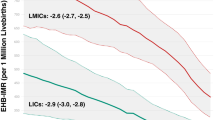Abstract
This paper reviews barriers to the prevention of kernicterus. Reports of kernicterus cases persist. We do not know why kernicterus continues to occur or how best to prevent it. We need evidence for key recommendations that make clinical guidelines usable by practitioners caring for newborns, especially for practitioners providing ambulatory care in the first week of life. Data on prevalence and incidence, mortality and morbidity are essential for launching a kernicterus public health campaign. Modeling cost-effectiveness requires data on costs and benefits of alternative strategies for managing hyperbilirubinemia and preventing kernicterus and on parental preferences concerning follow-up in the first days of life. Understanding how existing patterns of care obstruct preventive care involves exploration of the roles of clinicians, health-care organizations, parents, and payers and purchasers of health care. Lastly, discovering how to motivate change in existing practices can provide the guidance needed to prevent kernicterus in the US.
This is a preview of subscription content, access via your institution
Access options
Subscribe to this journal
Receive 12 print issues and online access
$259.00 per year
only $21.58 per issue
Buy this article
- Purchase on Springer Link
- Instant access to full article PDF
Prices may be subject to local taxes which are calculated during checkout
Similar content being viewed by others
References
Maisels MJ, Newman TB . Kernicterus in otherwise healthy, breast-fed term newborns. Pediatrics 1995;96(4):730–733.
MacDonald MG . Hidden risks: early discharge and bilirubin toxicity due to glucose 6-phosphate dehydrogenase deficiency. Pediatrics 1995;96(4):734–738.
Penn AA, Enzmann DR, Hahn JS, Stevenson DK . Kernicterus in a full term infant. Pediatrics 1994;93(6):1003–1006.
Washington EC, Ector W, Abboud M, Ohning B, Holding KR . Hemolytic jaundice due to G6PD deficiency causing kernicterus in a newborn female. South Med J 1995;88:776–779.
American Academy of Pediatrics, Provisional Committee for Quality Improvement, Robertson WO, Almquist JR, Light IJ, et al. Practice parameter: management of hyperbilirubinemia in the healthy term newborn. Pediatrics 1994;94(4):558–565.
Maisels MJ, Kring E . Early discharge from the newborn nursery — effect on scheduling of follow-up visits by pediatricians. Pediatrics 1997;100(1):72–74.
Newman TB, Xiong B, Gonzales VM, Escobar GJ . Prediction and prevention of extreme neonatal hyperbilirubinemia in a mature health maintenance organization. Arch Pediatr Adolesc Med 2000;154(11):1140–1147.
Soskolne EI, Schumacher R, Fyock C, Young ML, Schork A . The effects of early discharge and other factors on readmission rates of newborns. Arch Pediatr Adolesc Med 1996;150:373–379.
Parisi EA . Early postpartum discharge: recommendations from a preliminary report to Congress. Pediatrics 2001;107(2):400–404.
Galbraith AA, Egerter SA, Marchi KS, Chavz G, Braverman PA . Newborn early discharge revisited: are California newborns receiving recommended postnatal services? Pediatrics 2003;111(2):364–371.
Johnson L, Bhutani VK, Brown AK . System-based approach to management of neonatal jaundice and prevention of kernicterus. J Pediatr 2002;140(4):396–403.
Parents of Infants and Children with Kernicterus. P.I.C.K. www.pickonline.org.
AAP Subcommittee on Neonatal Hyperbilirubinemia. Neonatal jaundice and kernicterus. Pediatrics 2001;108(3):763–765.
Bhutani VK, Johnson LH, Sivieri EM . Predictive ability of a predischarge hour-specific serum bilirubin for subsequent significant hyperbilirubinemia in health term and near-term newborns. Pediatrics 1999;103(1):6–14.
Bhutani VK, Gourley GR, Adler S, Kreamer B, Dalin C, Johnson LH . Noninvasive measurement of total serum bilirubin in a multiracial predischarge newborn population to assess the risk of severe hyperbilirubinemia. Pediatrics 2000;106(2):1–9.
Stevenson DK, Fanaroff A, Maisels MJ, et al. Prediction of hyperbilirubinemia in near-term and term infants. J Perinatol 2001;21(Suppl):S63–S73.
Nathaniel Johns v Franciscan Health SystemWest et al.. Docket no 99-2-04211-5KNT Filed May 19 1997.
Palmer RH, Clanton M, Ezhuthachan S, et al. Applying the ten simple rules of the Institute of Medicine to Management of Hyperbilirubinemia in Newborns. Pediatrics 2003;111(6):1388–1393.
Acknowledgements
This paper was presented at the National Institute of Child Health and Human Development (NICHD) Conference: “Research on Prevention of Bilirubin-Induced Brain Injury”, July 21–22, 2003, Washington DC. This study was supported by Grant RO1 HS09782 from the Agency for Healthcare Research and Quality, Rockville MD (Palmer) and by Grant K23 HD043179-01 from the National Institute of Child Health and Human Development, Bethesda, MD (Keren).
Author information
Authors and Affiliations
Rights and permissions
About this article
Cite this article
Heather Palmer, R., Keren, R., Jeffrey Maisels, M. et al. National Institute of Child Health and Human Development (NICHD) Conference on Kernicterus: A Population Perspective on Prevention of Kernicterus. J Perinatol 24, 723–725 (2004). https://doi.org/10.1038/sj.jp.7211153
Published:
Issue Date:
DOI: https://doi.org/10.1038/sj.jp.7211153
This article is cited by
-
Clinical report from the pilot USA Kernicterus Registry (1992 to 2004)
Journal of Perinatology (2009)



